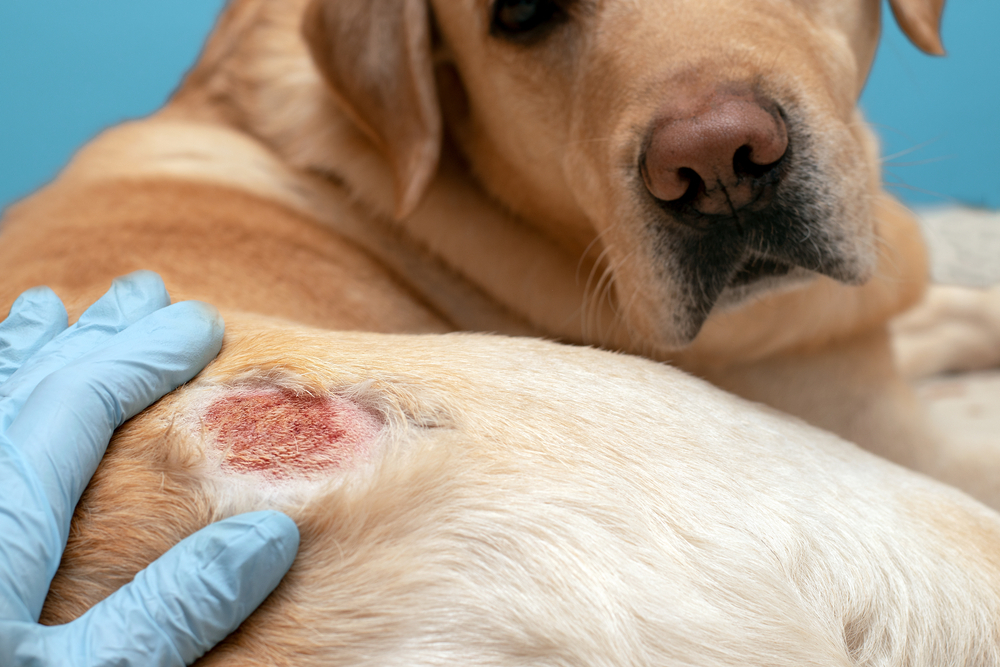
Even though they have a fairly protective covering of hair, dogs are still vulnerable to bug bites. This is because they tend to investigate everything with their noses and spend a lot of time close to the ground. Below, we’ll discuss some of the most common types of bug bites on dogs, as well as signs to look for and what you should do about the bites.


Common Bug Bites
Some bugs, like fleas, can be found virtually anywhere. Others, like some types of ticks, are found near water. Determining the type of bug that has bitten your dog can determine the best course of action. Some of the most likely culprits of bug bites on your dog are detailed below.
Fleas
Fleas are tiny pests that can jump incredible distances, are typically brought in from outdoors, and they can pass from one dog to another. Once they’re on your dog, they will breed and multiply, and if you don’t take action to get rid of fleas as soon as you see them, the problem can become much worse.
Bites can be difficult to spot, but you will likely notice your dog scratching and even biting their skin, and you might be able to spot the red bumps that are telltale signs of flea bites.
Try combing your dog’s fur and looking for signs of flea dirt and live insects on the comb. Flea bite dermatitis is a severe reaction to the bites where dogs become incredibly itchy and often develop a rash complete with raised red bumps and swelling mainly at the base of the tail. A single bite can trigger it. It’s best to get a prescription from your vet to eliminate the fleas, and you’ll also have to treat all animals in your home as well as your house and yard to eradicate an infestation.


Ticks
Ticks are tiny eight-legged arachnids that feed on mammals. They typically live in grass or shrubs, often near bodies of water, and they will hitch a ride on your dog as they walk through the undergrowth.
They bite and suck blood from your dog. You’ll often find the tick still attached to your dog as it feeds. Otherwise, you may notice an area of redness or swelling if the tick has already let go. Ticks are commonly found around the neck, ears, head, and feet.
You can remove them carefully with tweezers or use a tick-removal tool. However, if your dog has several ticks and is displaying signs of being sick, take them to the veterinarian. Your vet can remove the ticks, examine your dog for infections, and prescribe a preventative treatment to keep them from returning. You might also consider taking a different route on your next dog walk to prevent a re-infestation.
💛 🐶 Speak To a Vet Online From the Comfort of Your Couch!


If you need to speak with a vet but can’t get to one, head over to PangoVet. It’s an online service where you can talk to a vet online and get the personalized advice you need for your pet — all at an affordable price!
Mites
Mites are even more challenging to detect than fleas and ticks, and it is virtually impossible to see individual bites. However, if your dog gets bitten multiple times, it can cause them to lose fur in that area, as well as some biting and scratching.
Sarcoptic mange is one of the most common mites that affect dogs, and it is very contagious. It can be passed on from other dogs and even objects in the environment. If your dog is affected, you need to make a veterinary appointment as soon as possible to start treatment.


Mosquitoes
Mosquitoes not only bite people but will also bite pets. Mosquitoes are easier to see than fleas and mites, and their bites tend to leave behind a raised red skin lesion that is easy to detect. If you’ve ever suffered mosquito bites, you are looking for similar-looking bites on your dog.
Ensure your dog is on a heartworm preventative because if a mosquito is infected with heartworm, a single bite is enough to pass them along to your dog. You can get dog-safe bug repellent sprays that can help deter mosquitoes, but they are not always effective at eliminating the problem.
Bees And Wasps
Bees, wasps, and hornets can also sting canines. Generally, the sting causes enough pain to cause a physical reaction from your dog, such as crying or barking.
Stings can also cause redness and swelling, and some dogs may have allergic reactions to the stings which can cause considerable swelling and difficulty breathing and swallowing. If your dog shows signs of an allergic reaction, you must see a vet immediately because the reaction can lead to life threatening breathing problems.
These stinging insects are more common during the summer months, and there is little you can do to avoid coming into contact with them. You should discourage your dog from approaching them and find walking routes with fewer stinging insects.


Fire Ants
Fire ant bites can be extremely painful, and if your dog walks over a fire ant nest or comes into contact with several fire ants, they can suffer multiple bites in quick succession. As with bee stings, fire ant bites can cause allergic reactions, and some are severe, so you should contact a vet if your dog shows signs of a reaction.
Brush or wash off any ants you see on your dog, and if you have them in your yard, use a commercial pesticide or pay a professional to get rid of them.
Spiders
Venomous spiders can bite and cause severe reactions in dogs, even if their venom does not have enough potency to be considered dangerous to people. Unfortunately, the bites can be difficult to spot immediately, so you may not know your dog has been bitten by a spider until days later when the skin becomes inflamed and necrotic.
If your dog has been bitten, reacting quickly is vital and could save your dog’s life. Ideally, if you can describe the spider to the vet, it will help them identify the venom affecting your pup and help them determine the best course of action.


What To Do If Your Dog Has Been Bitten
Most insect bites are relatively harmless to dogs, but some can be dangerous, especially if your dog has an allergic reaction to them. If you see signs of a bite, try to determine the likely culprit.
Watch for any negative reaction to the bite and apply a cold press to reduce swelling. If you see signs like lethargy, panting, or difficulty breathing, contact a vet immediately so they can advise you on the best steps to take.

 Conclusion
Conclusion
Dogs are inquisitive animals that like to investigate everything from patches of grass to ant hills. Their inquisitive nature and proximity to the ground and plants mean that dogs can be prone to being bitten by bugs.
Flea bites are the most common bug bites, but mite and tick bites are fairly common as well. Bee and wasp stings, although not strictly bites, along with bites from some spiders, can be very serious, especially if your dog has an allergic reaction to it.. Contacting your vet for an appointment is vital if your dog is stung or bitten and displays concerning signs.
Featured Image Credit: Photo-Vista.de, Shutterstock



